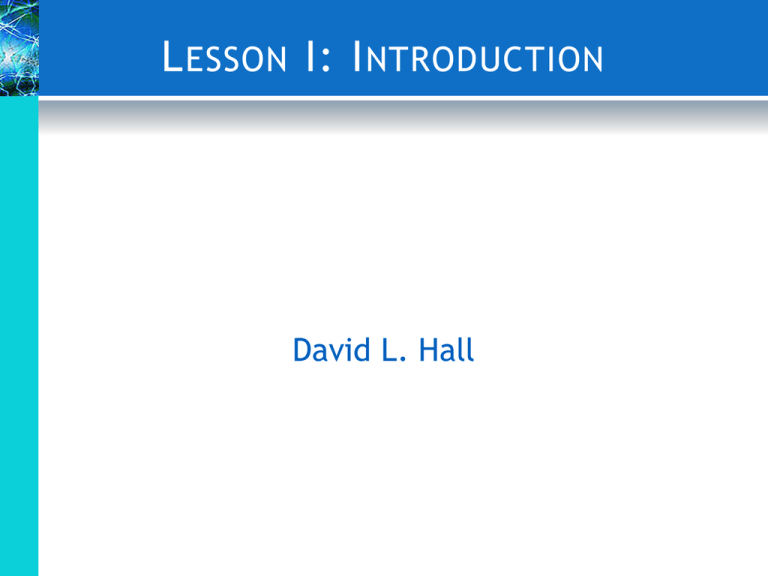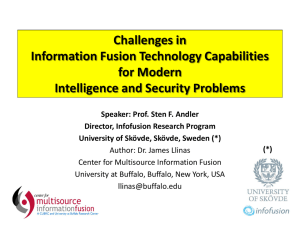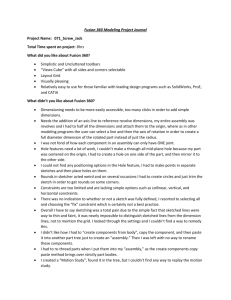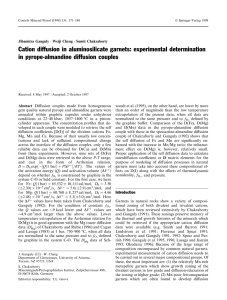Handbook of Multisensor Data Fusion
advertisement

L ESSON I: I NTRODUCTION David L. Hall L ESSON O BJECTIVES Introduce this course and instructor Provide an understanding of the course logistics, requirements, grading, assignments, and ground rules Introduce the topic of data and information fusion C OURSE O BJECTIVES To provide an introduction to the field of data and information fusion Models of multisensor data fusion The JDL Data Fusion Process Model Techniques for data fusion ranging from estimation to pattern recognition and automated reasoning Guide you through a team exercise involving design of a data fusion system to address a selected application Present a balanced view of the advantages and limitations of fusion Understand the role of the human in the loop analyst/decision maker Provide a basis for further study and specialization R EVEALING MY PEDAGOGICAL HAND Brief presentations In-class (on-line) exercises Humor and stories On-line discussion & presentations Planned time for group meetings & work It is important that you: 1) Participate every week 2) Focus on and complete on-line materials, lecture material, readings, assignments. O N -L INE M ATERIALS On-line Lessons • Site navigation on LHS • Each lesson summarizes • Video pre-view • Introduction • Lesson objectives • Commentary & discussion • Activities & assignments • Links to readings (via electronic library reserve) • Electronic copy of Lecture materials T EXT AND R EADINGS Assigned Text • D. Hall and S. A. McMullen, Mathematical Techniques in Multisensor Data Fusion, Artech House, 2004 Selected Readings • D. Hall and J. Llinas, editors, Handbook of Multisensor Data Fusion, CRC Press, 2001 • Excerpts from selected textbooks • Selected technical papers • One science fiction story C OURSE L ESSONS 1. 2. 3. 4. 5. 6. 7. 8. 9. Introduction JDL Model Project initiation Sensor processing Level 0 processing Level 1 – Correlation Level 1 – Estimation Level 1 – Target ID Systems Engineering 10. 11. 12. 13. 14. 15. 16. 17. 10. Project design Level 2 (situation refinement) Level 3 (Consequence refinement) Level 4 – Process refinement Level 5 – Cognitive refinement Project detailed design Data Fusion state of the art Final Presentation A SSIGNMENTS & W EIGHTS Individual Assignments and weights (70 %) • Ten (10) low stakes quizzes (20 %) • Six (6) on-line discussion participation (15 %) • Eight (8) Individual writing assignments (24 %) • Peer evaluation (11 %) Group project and weights (30 %) • Final technical report (20 %) • Final presentation (10 %) G ROUND R ULES Attendance/participation & preparation Plagiarism (cheating) Academic integrity Affirmative Action & Sexual Harassment Americans with Disabilities Act You have one week to question or dispute grades, missed assignments, or missed classes: Note – I dislike “wheedling” for extra credit T HE ORIGIN OF MULTISENSOR DATA FUSION “I say fifty, maybe a hundred horses . . . What do you say, Red Eagle?” B IOLOGICAL ORIGINS OF SENSOR FUSION Smell Sight Touch Sound Chemical detection Sonar A UGMENTATION OF SINGLE SENSES A long history of single sense augmentation has included eyeglasses, hearing aids, telescopes, microscopes (and more recently electronic noses, chemical detectors and many others A UGMENTATION OF COGNITION Similar to the augmentation of our senses, a long history of effort has sought to augment out cognition Data fusion seeks to support the augmentation & automation of the multisensing, cognition process for improved awareness and understanding of the world JDL D ATA F USION M ODEL • Course organized using the JDL Model “Levels” • Hall and McMullen text organized around JDL model • Lessons in on-line site focus on JDL levels • Lessons systematically “walk through” the levels • Project focus on designing a data fusion system for selected application using the JDL framework D ATA F USION F UNCTIONAL M ODEL The JDL model (1987-91) and the draft revised model (1997) • Level 0 — Sub-Object Data Association and Estimation: pixel/signal level data association and characterization • Level 1 — Object Refinement: observation-to-track association, continuous state estimation (e.g. kinematics) and discrete state estimation (e.g. target type and ID) and prediction • Level 2 — Situation Refinement: object clustering and relational analysis, to include force structure and cross force relations, communications, physical context, etc. • Level 3 — Significance Estimation [Threat Refinement]: threat intent estimation, [event prediction], consequence prediction, susceptibility and vulnerability assessment • Level 4 — Process Refinement: adaptive search and processing (an element of resource management) Adapted from A. Steinberg J OINT D IRECTORS OF L ABORATORIES D ATA F USION S UBPANEL : DEFINITION OF DATA FUSION: A continuous process dealing with the association, correlation, and combination of data and information from multiple sources to achieve refined entity position and identity estimates, and complete and timely assessments of resulting situations and threats, and their significance. D EFINITIONS . . . • Sensor Fusion = Data Fusion from Multiple Sensors (same or different sensor types) • Data Fusion = Combining information to estimate or predict the state of some aspect of the world • Data Fusion Functions: – Data Alignment (etc.) (spatio-temporal, Traditional data normalization, Focus evidence conditioning) Platform – Data Association (hypothesize entities) – State Estimation Reports & Prediction Situation Cross-Force Relations Force Structure Unit (etc.) R EPRESENTATIVE D ATA F USION A PPLICATIONS FOR D EFENSE S YSTEMS SPECIFIC APPLICATIONS Ocean Surveillance Air-to-Air and Surface-to-Air Defense Battlefield Intelligence, Surveillance and Target Acquisition Strategic Warning and Defense INFERENCES BY DF PROCESS Detection, Tracking, Identification of Targets/Events Detection, Tracking Identification of Aircraft Detection and Identification of Potential Ground Targets Detection of Indications of Impending Strategic Actions Detection/Tracking of Ballistic Missiles and Warheads PRIMARY OBSERVABLE DATA EM Signals Acoustic Signals Nuclear Related Derived Observations (wake) EM Radiation EM Radiation EM Radiation Nuclear Related SURVEILLANCE VOLUME Hundreds of Nautical Miles Air/Surface/SubSurface Hundreds of Miles (Strategic) Miles (Tactical) Tens to Hundreds of Miles about a Battlefield Global SENSOR PLATFORMS Ships Aircraft Submarines Ground-based Ocean-based Ground-based Aircraft Ground-based Aircraft Satellites Aircraft R EPRESENTATIVE D ATA F USION A PPLICATIONS (N ON -D O D S YSTEMS ) SPECIFIC APPLICATIONS Condition-based Maintenance Robotics Medical Diagnosis Environmental Monitoring INFERENCES BY DF PROCESS Detection, characterization of system faults Recommendations for maintenance/corrective actions Object location, recognition Guide the locomotion of robot hands, feet, etc. Location, identification of tumors. abnormalities, and disease Identification, location of natural phenomena (earthquakes, weather) PRIMARY OBSERVABLE DATA EM Signals Acoustic Signals Magnetic Temperature X-rays TV Acoustic Signals EM Signals X-rays X-rays NMR Temperature IR Visual Inspection Chemical/Biological Data SAR Seismic EM Radiation Core Samples Chemical/Biological Data SURVEILLANCE VOLUME Microscopic inspection to hundreds of feet Microscopic to tens of feet about the robot SENSOR PLATFORMS Ships Aircraft Groundbased (e.g., factory) Robot Body Human body volume Laboratory Hundreds of miles miles (site monitoring) Satellites Aircraft Groundbased Underground Samples W HAT DOES DATA FUSION DO ? OPERATORS & SUPPORT SYSTEMS SENSORS MISSION ENVIRONMENT SOURCES MISSION EQUIPMENT & WEAPONRY TO SUPPORT OPERATES ON: • sensor data • processed data • reference data DATA FUSION FUNCTIONS • ASSOCIATION • ESTIMATION • PREDICTION • INFERENCING • ANALYSIS • ASSESSMENT • positional, identity, and attribute estimates about objects and events • situation refinement • refinement of enemy threats, vulnerabilities, opportunities H IERARCHY OF I NFERENCE T ECHNIQUES Type of Inference Applicable Techniques High - Situation Assessment - Behavior/Relationships of Entities - Identity, Attributes and Location of an Entity - Existence and Measurable Features of an Entity LEVEL INFERENCELEVEL INFERENCE - Threat Analysis Low - Knowledge-Based Techniques - Expert Systems - Scripts, Frames, Templating - Case-Based Reasoning - Genetic Algorithms - Decision-Level Techniques - Neural Nets - Cluster Algorithms - Fuzzy Logic - Estimation Techniques - Bayesian Nets - Maximum A Posteriori Probability (e.g. Kalman Filters, Bayesian) - Evidential Reasoning - Signal Processing Techniques M ULTI -L EVEL /M ULTI -P ERSPECTIVE I NFERENCING where Level O: Signal Refinement what when Level 1: Positional, Identity & Attribute Refinement who why Level 2: Situation Refinement how Level 3: Threat Refinement Level 4: Process Refinement DATA FUSION PROCESSING PHYSICAL OBJECTS individual organizations EVENTS specific aggregated TERRAIN & ENEMY TACTICS local global ENEMY DOCTRINE & OBJECTIVES specific global FRIENDLY VULNERABILITIES & MISSION options needs FRIENDLY ASSETS specific & global PN PN PN = (PN + 2) - PN B ENEFITS OF D ATA F USION : M ARGINAL G AIN OF A DDED S ENSORS 0.13 0.12 0.11 0.10 0.09 0.08 0.07 0.06 0.05 0.04 0.03 0.02 0.01 N=1(13 Sensors) N=3(35 Sensors) N=5(57 Sensors) 0.5 0.6 0.7 0.8 0.9 1.0 PN Single Sensor Probability of Correct Classification Nahin and Pokokski, IEEE AES, 16 May 1980. B ENEFITS OF D ATA F USION : E NHANCED S PATIAL R ESOLUTION FLIR and Radar Sensor Data Correlation FLIR RADAR TARGET REPORT LOS TARGET REPORT LOS SLANT RANGE UNCERTAINTY AZIMUTH UNCERTAINTY COMBINED SLANT RANGE UNCERTAINTY TARGET REPORT ELEVATION UNCERTAINTY TARGET REPORT AZIMUTH UNCERTAINTY RADAR ABSOLUTE UNCERTAINTY REGION ABSOLUTE UNCERTAINTY REGION INTERSECTION FLIR ABSOLUTE UNCERTAINTY REGION ELEVATION UNCERTAINTY Adapted from W.G. Pemberton, M.S. Dotterweich, and L.B. Hawkins, “An Overview of Fusion Techniques”, Proc. of the 1987 Tri-Service Data Fusion Symposium, vol. 1, 9-11 June 1987, pp. 115-123. T HE D O D L EGACY: E XTENSIVE R ESEARCH I NVESTMENTS • • • • • • • • • JDL Process model Taxonomy of Algorithms Lexicon Engineering Guidelines – Architecture Selection – Algorithm Selection Evolving Tool-kits Extensive Legacy of technical papers, books Training Materials Test-beds Numerous prototypes C HALLENGES IN D ATA F USION . . . Robust sensors: no perfect sensors available difficult to predict sensor performance unable to effectively task geographically distributed non-commensurate sensors Image and non-image fusion: no true fusion of imagery and non-imagery data unable to optimally translate image in time-series data into meaningful symbols no requisite models for coherent fusion of non-commensurate sensor data Robust target identification: insufficient training data unable to perform automated feature extraction no unified method for incorporating implicit and explicit information for identification (e.g., information learned from exemplars, model information, and cognitive-based contextual information) C HALLENGES IN D ATA F USION . . . Unified calculus of uncertainty (e.g., random set theory): do not know how to effectively use these techniques limited experience in trade-offs and use of fuzzy logic, rules probability, Dempster-Shafer’s method, etc. unsure how to select the best uncertainty method Pathetic cognitive models for Level 2 and 3: unknown how to select the appropriate knowledge representation techniques argue about competing methods do not know how to use hybrid methods unable to perform knowledge engineering C HALLENGES IN D ATA F USION . . . Non-commensurate sensors: uncertainty as how to optimize use of wildly non-commensurate sensors inability to know how to link decision needs to sensor management unable to effectively use 10N sensors no consensus on MOE/MOP Human computer interface (HCI): trendy and driven by technology and not cognitive needs of user suffer from the Gutenberg Bible syndrome no effective tools to overcome cognitive deficiencies unable to capitalize on built-in human pattern recognition (e.g., recognition of faces, concepts of harmony) D ATA F USION I SSUES . . . What algorithms or techniques are appropriate and optimal for a particular application? What architecture should be used (i.e., where in the processing flow should data be fused (viz. at the data, feature, or decision levels)? How should individual sensor data be processed to extract the maximum amount of information? What accuracy can realistically be achieved by a data fusion process? How can the fusion process be optimized in a dynamic sense? How does the data collection environment (i.e., signal propagation, target characteristics, etc.) affect the processing? Under what conditions does multi-sensor data fusion improve system operation (under what conditions does it impede or degrade performance)? L ESSON 1 A SSIGNMENTS Review the on-line introduction material (lesson 1) Read chapter 1 of Hall and McMullen Writing assignment 1: write a brief biographical sketch of yourself (to share with the class) Writing assignment 2: write a paragraph describing the occurrence of data fusion in a natural setting Team Assignment (T-1) - Meet with your assigned team to discuss the semester collaboration D ATA F USION T IP OF THE W EEK “Here’s where we plan to use data fusion.” Despite enormous amounts of funding for data fusion research – there is still no magic data fusion system or techniques!







